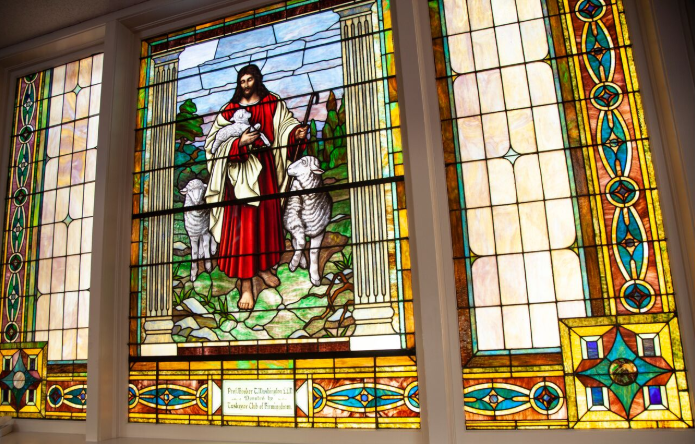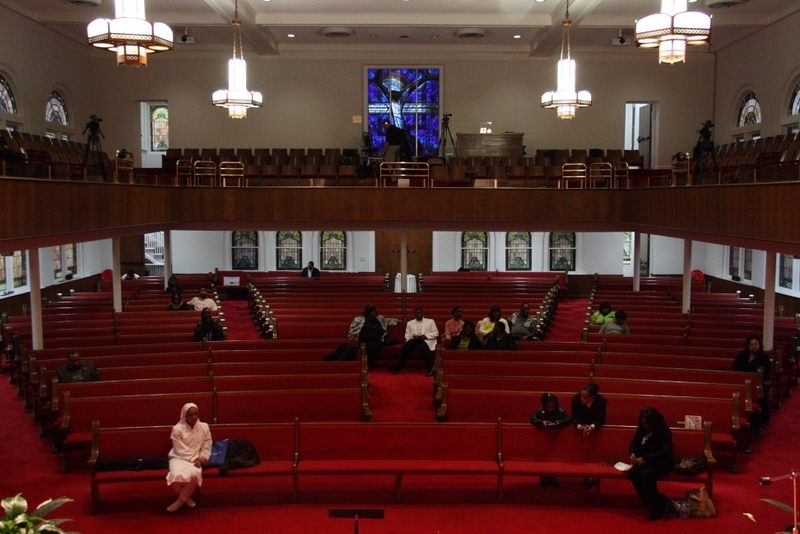Breaking the Window of Racism
By Jessica McCasland & Eva Parker

Seated high above the pews of a red-carpeted, early twentieth century Baptist church in the heart of Alabama, there is a stained-glass window that depicts Jesus in an uncommon manner: as a black man. Looking at his congregation with downcast eyes and a solemn face, his arms are outstretched and a rainbow crowns his head. Below him is a text inscription that reads: “You Do It To Me.” This innovative piece of art, the Wales Window for Alabama, is well-known for many reasons. It depicts Jesus as black man, it was a generous gift from the people of Wales, and perhaps most importantly it memorializes the young victims of a church bombing at the heart of the struggle for civil rights.
Sixteenth Street Baptist Church Bombing
It was a Sunday morning in mid-September 1963 when the ground floor of Sixteenth Street Baptist Church in downtown Birmingham shook with a sudden blast. Fifteen sticks of dynamite had been planted underneath the steps on the east side of the church by four members of the Ku Klux Klan, and in the explosion, four young, innocent Sunday school girls were killed; twenty-two others were injured.


The four young victims and the damaged church. Photo of damage Tom Self, Birmingham News. Birmingham Public Library Archives.
Addie Mae Collins, Carol Denise McNair, Carole Robertson, and Cynthia Wesley were just four of over one hundred tragic casualties resulting from white supremacists resisting the civil rights movement. The Klansmen’s cruel intention was “to terrorize the black community and their leaders, who had used the church as a meeting place, training ground and rallying point for the Birmingham Children’s Crusade and other direct actions,” but their crime, and the four unassuming martyrs, ricocheted into international news and drew a dramatic response (Baynes-Dunning, 2019).
This very crime is what inspired John Petts of Llansteffan, Carmarthenshire–four thousand miles away from Birmingham–to create the Wales Window. When he heard of the tragedy, he was horrified as both a “father and a craftsman in a meticulous craft” (Younge 2011). As such, he quickly offered his services to create a brand-new window and install it in the church to commemorate the girls. While the window was inspired by the damage to the church, it did not replace a damaged window. Those were restored. Instead it was installed as a third image of Jesus in the sanctuary.
The editor of the Western Mail newspaper, David Cole, started a front-page campaign to raise money for the window so that it was truly from all the people of Wales. In an incredibly short period of time, “the Western Mail’s campaign had gathered force, with black and white children alike queuing in Cardiff’s docklands to hand over whatever they could afford” (Prior 2011).
Symbols and Hidden Meanings
Within the span of two years, Petts had received the funds for the window, then designed, created, and delivered his gift from Wales to Alabama. It was dedicated and installed over the rear balcony of Sixteenth Street Baptist Church in June 1965, in memory of the four young victims. It overlooks the church and provides a sobering reminder as you gaze upon it from the altar below. Its design was unusual. It featured a “black Christ figure on a cross with arms and hands reaching up and out” (Wingard 2012).
Petts decided to depict the Christ figure in a manner that mirrored “a black protester taking part in a street demonstration in the South” as Pastor Christopher Hamlin explains:
“The man’s arms were flung above his head, and his body was gyrating as he was assaulted with fire hoses. The Jesus in the window Petts designed symbolized the crucified Christ and forms the upright beam of a cross, while a stylized stream of water from a fire hose forms the cross beam. He used a rainbow-colored nimbus on the Christ figure in the window to symbolize that God loves every person equally without respect to nationality, race or creed–for we are one in Christ Jesus” (Hamlin 1998, 63).
The meaning of the position of Jesus’s hands has been the subject of varying interpretations. A common one is that “the right one is pushing away hatred and injustice, the left offering forgiveness” (Younge 2011).
In large letters at the bottom, Petts included the words: “You Do It To Me”. These words, from Matthew 25:40 communicate the Christian ideal of brotherly love: “Truly, I say to you, as you did it to one of the least of these my brothers, you did it to me.” They also communicate Christ’s identification with those who suffer such as the protesters hit by fire hoses. These were the very words that the Reverend John Cross, the pastor of Sixteenth Street Baptist, “had intended to say in the sermon he did not give on Sunday, September 15, 1963: ‘You Did It to Me’” (Hamlin, 1998).
Modern Interpretations of the Window
Sixteenth Street’s current pastor the Reverend Arthur Price, acknowledges that the window is still controversial:
The boldness – in this country – of having a black Christ speaks volumes. For the African American community that’s not a stretch at all, but for many people in the white community during that time, to say that Jesus Christ was black and of African descent would be blasphemous. But I think the major message we try to take out of the window is not so much identifying Christ’s colour but knowing that Christ identifies with us. To the white community this is that the Jesus you love identifies himself with the African American community, so you are really crucifying him again when you persecute someone who does not look like you (Younge 2011).
Essentially, Price is saying that Christ’s racial identification with blacks is something that the white community of believers sees as taboo, and in order to fully identify with Christ as Savior, one must give up their preconceived notions of what Jesus looks like to them.
Haven Voorhees, a junior at Samford University, had an entirely different interpretation and perspective of the window.
At my initial glance, the symbolism behind Jesus’s hands meant ‘peace and victory’ because you see Jesus with His arms outstretched, which is the universal sign for victory. Additionally, blue is known as a color for washing away, like purity and peace, and the entire background is blue. But when you do more than a glance, you see what the picture is actually conveying which is someone with a downcast spirit who is solemn and is falling to their knees. You see, ‘You Do It To Me,’ with that, the response can go both ways: Someone can either perceive it as Christ on the cross, or it can be tied to something non-religious, like the oppression from the Civil Rights Era. My first response, without knowing where this window was located, is that it wasn’t religious, so the fact that it’s in a church gives an interesting double meaning behind it. It resembles the dichotomy between victory and oppression post-Civil Rights Era.
Voorhees’s initial view of the window did not indicate any religious associations; in fact she thought it was more Civil-Rights-related than anything else. She saw the window far more symbolically and politically, rather than religiously, as most viewers do.
Voorhees and Price both recognize the importance of the figure’s skin color and body position. While the image is perceived in many ways its identification of Jesus with the victims of racial discrimination is hard to escape. When the image of a black Jesus in a cruciform position is considered in the context with the church’s order stained glass windows of a white Jesus knocking at a door and as a good shepherd, the church bears witness to Christ being from and for all races and not only Lord, but also forgiving and redeeming fellow sufferer.

Jesus the Good Shepherd 
Christ at the Door 
Wales Window in Context 
Wales Window For Alabama
Medium: Stained glass
Artist: John Petts (Welsh)
Created and Installed: 1964
Location: Sixteenth Street Baptist Church, 1560 Sixth Avenue North, Birmingham, AL 35203
Sources For Further Information
Baynes-Dunning, Karen. 2019. “Remembering the Birmingham Church Bombing.” Southern Poverty Law Center, https://www.splcenter.org/news/2019/09/15/remembering-birmingham-church-bombing.
Eastwood, Jon. 2018. “The Iconic Wales Window Inside 16th Street Baptist Church.” Birmingham Time, https://www.birminghamtimes.com/2018/10/the-iconic-wales-window-inside-16th-street-baptist-church/
Hamlin, Christopher. 1998. Behind the Stained Glass: A History of Sixteenth Street Baptist Church. Birmingham, AL.: Crane Hill.
Prior, Neil. 2011. “Alabama Church Bombing Victims Honoured By Welsh Window.” BBC News, https://www.bbc.com/news/uk-wales-12692760
Wingard, Leslie E. 2012. “As Seen Through Stained Glass: Religion, Politics, and Aesthetics in Alice Walker’s ‘Meridian’”. Religion & Literature 44. https://www.jstor.org/stable/23347060?read-now=1&seq=1
Younge, Gary. 6 March 2011. “American Civil Rights: the Welsh Connection.” The Guardian, https://www.theguardian.com/artanddesign/2011/mar/06/racist-attack-alabama-1963-gary-younge.
Jessica McCasland ‘21 and Eva Parker ‘21 were students in The Craft of Religious Studies in Samford University’s Department of Biblical and Religious Studies in spring 2020.
Published April 1, 2020.
Where can I purchase a copy of the Wales Window?
LikeLike
That is a great question. I know images of it appear on some things that the Birmingham Civil Rights Institute has sold over the years. I imagine the church owns the rights, I don’t that they have authorized many reproductions.
LikeLike